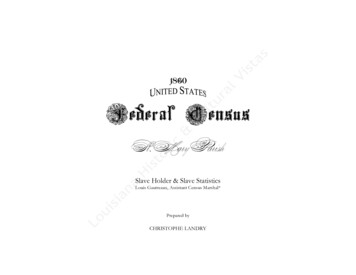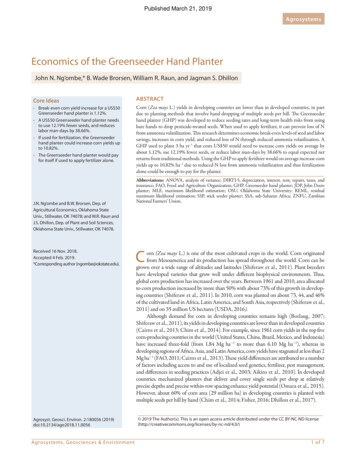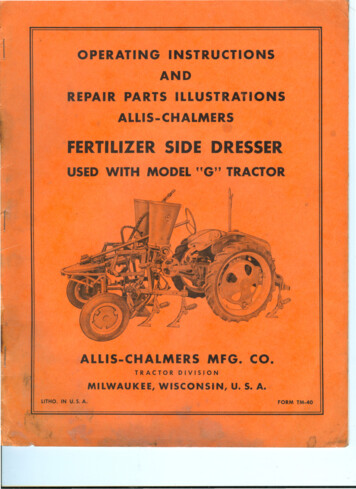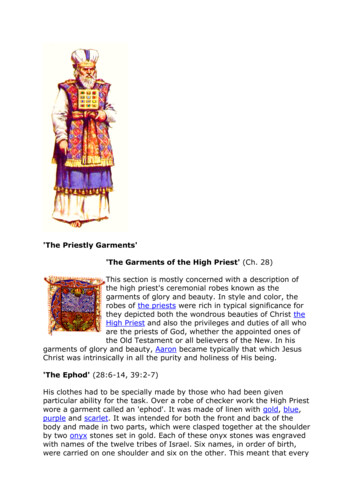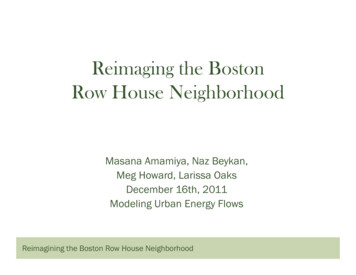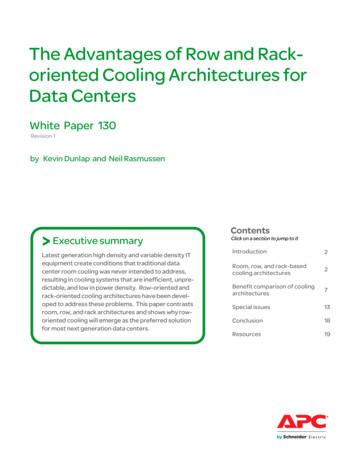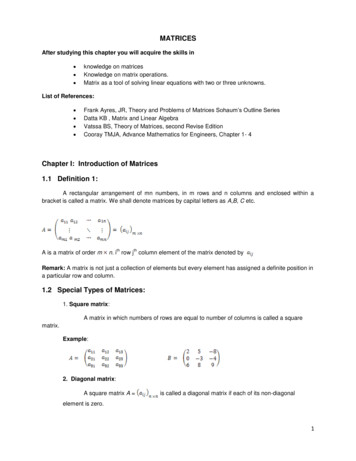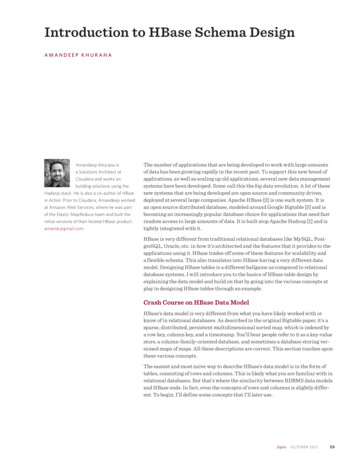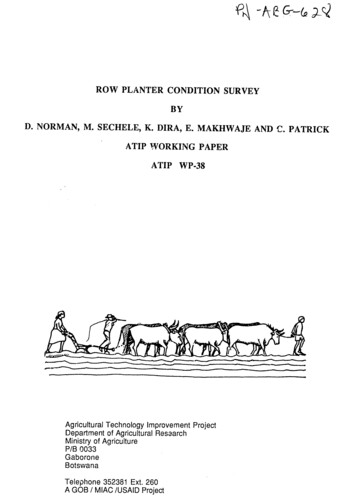
Transcription
ROW PLANTER CONDITION SURVEYBYD. NORMAN, M. SECHELE, K. DIRA, E. MAKHWAJE AND C. PATRICKATIP WORKING PAPERATIP WP-38Agricultural Technology Improvement ProjectDepartment of Agricultural ResearchMinistry of AgricultureP/B 0033GaboroneBotswanaTelephone 352381 Ext. 260A GOB / MIAC /USAID Project
*AGRICULTURALTECHNOLOGY IMPROVEMENT PROJECT*(ATIP)ROW PLANTER CONDITION SURVEYBYD. NORMAN, M. SECHELE, K. DIRA, E. MAKHWAJEAND C. PATRICKATIP WORKING PAPERATIP WP-38DEPARTMENT OF AGRIC. RESEARCHMINISTRY OF AGRICULTUREBOTSWANASEPTEMBERMID-AMERICA INTERNATIONALAGRICULTURAL CONSORTIUM(MIAC)1990PRINTED: September 11, 1990ADDRESSES:P/BAG 0033GABORONEP.O. BOX 10MAHALAPYEP.O. BOX( 10275TATITOWN (FRANCISTOWN)ATIP WORKING PAPERS CONSIST OF METHODOLOGICAL AND EMPIRICALMATERIAL WHICH HAS BEEN REVIEWED INTERNALLY BY ATIP BUTDO NOT NECESSARILY REFLECT THE VIEWS OFTHE DEPARTMENT OF AGRICULTURAL RESEARCH;MINISTRY OF AGRICULTURE, BOTSWANA*t::.: :,:::::,,,,:*
ACKNOWLEDGEMENTSThanks are extended to F. Worman and L. Modidi for supervising the implementation of thesurvey in the Francistown and Southern Regions. The help of the enumerators involved incollecting the data and the farmers who provided the information is gratefully acKnowledged.Finally appreciation is extended to E. Modiakgotla and J. Siebert who not only providedconstructive suggestions on the survey form but together with G. Ramolemana also reviewedthe manuscript.File: WOOIWP-38-iDate: September 11, 1990
ROW PLANTER CONDITION SURVEYCONTENTS1. Introduction . .1.1 Justification for the survey.1.2 Select.ion of the sample.1.3 Implementing and analyzing the survey.2.Household Information.33. Planter Information.4.5.11134Undertaking Row Planting.4.1 Row planting. . .-.4.2 Practices associated with row planting.666.Advantages And Disadvantages Ot Row Planting.5.1 Advantages of row planting.5.2 Major problems of row planting.5.3 Dealing with the problems.99910.6. Lockilg After Row Planters. 13.7. Independent Evaluation.7.1 Background.7.2 Farmers' knowledge concerning row planting.7.3 Condition of the row planter.8. Conclusions And bution of planters in survey, by villageCharacteristics of Households.Information on planters.Amount paid for planters.Use of planters.Practices of farmers using row planters.Level of row planting and inter-row cultivationFarmer indications of advantages of row planting compared to broadcastingProblems faced by farmers in using row planters .11Dealing with row planter problems .Looking after row planters .Evaluation of farmers technical knowledge. .16Evaluation of farmers' knowledge of row plantingEvaluation of current condition of row planters.Overall condition of row planters . .File: W100/WP-38- ii -.245578891214161718Date: September 11, 1990
ROW PLANTER CONDITION SURVEY1. INTRODUCTION1.1 Justification For The SurveyRow planting recommendations have been available for many years in Botswana. In spite ofthis, relatively few farmers row plant and even fewer produce technically good results.Lack of knowledge concerning the benefits of row planting (e.g., improved weed controlthrough inter-row cultivation), combined with limited managerial skills with respect to therow planting operation itself, have undoubtedly contributed to the low levels of adoption andto the rather mediocre results that are often obtained. During the last two or three years,recognition of this problem has prompted extension and ATIP staff in the Mahalapye area, toactively promote the merits of row planting. The combined efforts of these personnel haveinvolved the running of farmer training courses for row planting [Siebert, Modiakgotla,Molatsi and Caplan, 19901, the organisation of row planting and inter-row cultivationcompetitions at Agricultural Shows [Modiakgotla, Siebert, Makhwaje and Dira, 1990], andeven the testing of a custom-hire row planting scheme [Modiakgotla, 19891.It has also been recognised that some of the poor results obtained from row planting maynot only be due to a lack of knowledge on the part of farmers about the technicalities ofrow planting, but may also be attributable to the poor condition of many of the row plantersthat farmers own.because of this, and an interest expressed by the Arable LandsDevelopment Programme (ALDEP), ATIP Mahalapye proposed that a survey be undertakenof a sample of row planters to ascertain their condition, causes for the poor condition whenthey existed, and to evaluate farmers' opinions and knowledge about row planting.As a result, a survey was designed in collaboration with ALDEP, Farm MachineryDevelopment Unit (FMDU), ATIP Francistown and Farming Systems Southern Region(FSSR). FMDU were keen on collaborating in the survey and in fact provided a staffmember (M. Sechele) who evaluated ali the row planters included in the survey, except forthose in the Francistown region. ATIP Francistown and FSSR also agreed to participate inthe survey in order to provide a larger sample for more areas of the country.1.2 Selection Of The SampleThe largest sample was selected in the Central Agricultural Region where initial interest insuch a survey was greatest. Smaller samples were selected in the ATIP Francistown andFSSR areas.Because of a lack of a sampling frame of those farmers who owned row planters, thisinformation was obtained from knowledgeable people in each of the villages surveyed. ADsproved to be particularly helpful in this respect. The object was to obtain a sampleconsisting of farmers who owned row planters and who did not use them as well as thosewho used them.Table I indicates the numbers of farmers with row planters contacted in the three regions.The number of villages where farmers were contacted totalled 17 and these in turn werelocated in seven districts. The villages primarily consisted of those where farming systemteam activities had been undertaken by ATi? or FSSR. In addition, Mookane was includedbecause farmers there had a tradition of row planting and Sefhare was included because aFile: WIOOIWP-38-I-Date: September 12, 1990
TABLE 1:DISTRIBUTION OF PLANTERS IN SURVEY, BY VILLAGEaREGIONDISTRICTVILLAGESAFIM 32320141710157RPSEBELE FPS90 RPSA WONDER RP OTHER RPLTOTALNumt.: r- nwned:FrancisuwnTutumeSu!.;total.CentrtlMahalapye EastMahaiapye WestPalapyeS) :: total:ISout:.r,-,Ngwaketse CentralNgwaketse NorthSInt total:Totai -------------Perc.niageb-eakdown:Fs. 100.0RP in table means row planter and PP means plough planter. The same applies to all the other tablesin the report.include Pitman (4 planters), Bulawayo Tiger (2), S71 (2), Vetsak (1), and John Deer (1).File: WI00/WP-38.TBLDate: September 10, 1990
row planting training course had been held recently in the general vicinity. The totalnumber of farmers in the sample were 157. Fifty-three percent of that sample came fromthe Central Region where the initial request for the Row Planter Condition survey originated.The other 50 percent were equally divided between the Southern and Francistown regions.The way in which the sample was selected could have resulted in possible biases.Unfortunately it is not possible without a great deal of effort to verify whether these, in fact,did occur. The biases could have arisen because:(a).Knowledgeable people, who were asked to indicate those farmers who had rowplanters, were likely to mention those who had row planters that were being currentlyused. Therefore the row planters examined in the survey could have been biasedtowards those that were in better condition.(b).Agricultural Demonstrators (ADs) who constituted part of the knowledgeable groupcontacted about farmers owning row planters were likely to know about those theyhad day-to-day contact with. These could possibly have been the wealthier farmers.On balance, after due consideration, we do not believe that there were serious biases in theselection of the samples. Other surveys in the ATIP areas indicated that very few farmers inthe villages where the project was operational, owned row planters [ATIP 1986A, p. 15;ATIP 1986B, p. 21]. Therefore, all the farmers who owned row planters were known toproject and other personnel. Also since few farmers owned them, and the ones who did hadto have good access to draught power, it is probable that they were the more progressiveand wealthier farmers, The fact that, at least until relatively recently when ALDEP becameinfluential, farmers owning row planters tended to be wealthier, has been informally observedby ATIP staff.1.3Implementing And Analyzing The SurveyA questionnaire was designed by ATIP in consultation with FSSR and FMDU. The survey,which is attached as an Appendix to thiS report, consisted of four parts. Parts 1 to 3 wereadministered by enumerators while Part 4 was completed by the staff member from FMDU.The first three parts were completed for all the 157 farmers surveyed, while Part 4 was forfarmers in the Central and Southern Regions.2. HOUSEHOLD INFORMATIONTable 2 indicates the household characteristics of the sampled families. The average age ofthe household head was about 58 years old and the size of the household was almost sevenpersons. There did appear to be a wealth bias in the ownership of row planters. Evidencefor the fact that households tended to be wealthier were the following:(a).As many as 83 percent of the households were male-headed. Other studies carriedout by ATIP have indicated that at least 30 to 40 percent of the households werefemale-headed, and that these households tended to be poorer [ATIP 1986A, p. 20;ATIP 1986B, p. 211.(b).A useful proxy for wealth is the number of cattle owned. Only about nine percentof the sampled households did not own cattle. In other ATIP studies the percentageof families not owning cattle was much higher [ATIP 1986A, p. 15; ATIP 1986B, p.181.File: WIOO/WP-38-3-Date: September 11, 1990
There seemed to be no particular differentiation in terms of household characteristics orwealth, by planter type.About 12 percent of the farmers, in fact, owned more than one row planter although most ofthe time only one row planter was currently being used.TABLE 2:CHARACTERISTICS OF IIOUSEHOLDS'SEX -Hi(% MALE)Satim RPSebele RPScbele PP590 RPSA Wonder RPOther RPTotalNRca.b.c.AGE 111(YEARS)SIZE OFHOUSEHOLDPERCENT I!tNOS. DONKEYSWITIOUT CAT'LE PER 54157-111 in table refers to household head.Means percent of households owning more than one row planter.NR refers to the number of responses.3. PLANTER INFORMATIONReturning to Table 1, the Safim constituted by far the most common row planter (i.e., nearly47 percent). The next most popular planters were the Sebele Row Planter and the SebelePlough Planter. In the Francistown and Southern regions the Safim Row Planter was verydominant, but in the Central Region the lower numbers of Safim Row Planters werecompensated by a much higher presence of Sebele Plough Planters. At the time of thesurvey (1989) the average age of row planters was seven years old (Table 3). However,Safim Row Planters tended to be older while the Sebele Row Planter and Plough Planterwere obviously much younger since they were introduced relatively recently.Single row planters dominated and were usually pulled by animals. In order to operate suchplanters two people were usually required, most commonly consisting of a man and child.Donkeys, presumably because they were easier to control, were much more commonly usedthan oxen in the planting operation. For the Safim and Sebele Row Planters, two oxen ortwo donkeys were necessary for the planting operation. However, the Sebele Plough Planter,which combines the operations of ploughing and planting, requires considerably more draughtand therefore a much larger team of animals, for its operation. When two row planters wereused more animals were required.Tractors were only used by about 23 percent of the farmers for the row planting operation.Where tractors were used, only one person was often involved in the planting operation.Table 4 indicates the prices of the different planters when they were purchased. Very littlemeaningful information can be obtained from this table, since obviously the prices vary withthe yes- when they were purchased, and were often confused by the subsidy elements inpurchasing planters in more recent years. The table reflects the prices farmers actually paid."--4 -Date: September 11, 1990
TABLE 3:INFORMATION ON PLANTERSSAFIM RPSEBELE RPSEBELE PPS90 RPSA WONDER RPOTHER RPTOTALYear purchasedNR1979198819871973198419821982152Number of rows11122--157Operation: Median number of people2Most common combinationb MC2MC2M2M1M2M/MC2MC87137Pulled by (percent):TractorOxenDonkeysBoth oxen and 863.42.81154Row planter pulled by (number animals) :Oxen2282-2231Donkeys2286-2281a.In all the tables in the report '--' means not available, not relevant, and/or not applicable. 'NR' represents the numberof responses. The 'NR' did not always equal the size ofsample (i.e., 157), because of the nature of the question, missing information and/or the fact that more than one responseto the question was possible.b.'M' equals a male adult and 'C' equals a child.c.There was no most common combination. Both listed were equally common.d.Most common number.TABLE 4:AMOUNT PAID FOR PLANTERSSAFIM RPNumber of planters10Price47.001970 - 1979:Number of planters9Price324.531980 - 1982:Number of planters12Price162.111981 - 1985:Number of planters8Price173.111986:Number of planters4Price56.251987:Number of planters3Price270.341988:Number of planters6Price277.001989:Number of planters-Price-a.That is after any subsidies have been subtracted.1959 - 1969:file: W100/WP-38.TBLSEBELE RP.SEBELE 0499.275135.00551.52285S90 RP5112.505762001800.00--21337.5011600.00-----SA WONDER RP OTHER RP-1-600.0012500.001150.003-1300.00- 211500.0030.0041700.00- 4-2598.75- 13450.00703.771-750.00- Dale: September 10, 1990
4. UNDERTAKING ROW PLANTING4.1 Row PlantingQuestions with reference to the use of the row planter revealed some interesting information.Twenty-four percent of the row planters were not used every year and when they were lastused only 38 percent of the sampled farmers row planted their whole field. The majorreasons for not row planting were labour shortage, problems with the planter, and rains beingtoo little and/or too late.With reference to the problems with row planting, it was interesting to note that when thesample was divided into two equal halves, 32 percent of the row planters purchased before1986 were not used every year, while nearly 15 percent of the row planters purchased after1985 were not used every year. This implies that the older the machine was, the morelikely there were problems with row planting.On average, farmers in the survey planted a total of 16.6 hectares per year, of which 13.7hectares, or 83 percent of the total land planted, was in fact row planted (Table 5). It is notunreasonable to expect some broadcast planting to be undertaken. ATIP has, over the years,argued that it is possible that farmers need to use a number of different strategies forundertaking farm operations, depending on how the rains develop. If time is short, it islikely that farmers would broadcast their seed if they needed to undertake both ploughingand planting operations and did not have the Scbele Plough Planter. The average of 16.6hectares planted is considerably higher than many farmers surveyed in other ATIP studies[ATIP 1986A, p. 20; ATIP 1986B, p. 39]. This once again reflects the better resource baseof farmers owning row planters. However, it should be noted that the figures for thoseusing te animal drawn planters -- particularly the Safim Row Planter and the Sebele RowPlanter and the Sebele Plough Planter -- are more in line with what farmers normally planteach year.4.2 Practices Associated With Row PlantingSorghum and maize were most commonly sown with row planters while millet and melonswere rarely sown with row planters. A surprisingly high percentage of farmers used manureon their fields (26 percent) while an even higher percentage (62 percent) of the farmers usedinorganic fertilizer. Phosphatic and compound fertilizers were by far most commonly usedand tended to be applied at planting or before planting, using the broadcast method (Table6).'Land preparation for row planting usually involved the traditional single ploughing approach,although on occasion some found that another ploughing or some other form of cultivationwas necessary to provide a decent seedbed for row planting (Table 6).One of the benefits of row planting is of course to be able to weed mechanically. However,62 percent of the farmers (Table 6) weeded only by hand.Those who did weedmechanically invariably used the Mahon cultivator which they owned. The uncommonpractice of inter-row cultivation probably reflects two points:'Small amounts of fertilizer were availablc, via the Accelerated Rainfed AgriculturalProgramm. ".%RAP), free of charge during the later drought years of the 1980'sUnfortunately no figures were obtained on tle amount of fertilizer used.File: W100/WP-38- 6-Date: September 11, 1990
TABLE 5:-.1*USE OF PLANTERS'Row planter used every year (percent)?SAFIM RP72.6SEBELE RP78.3If not used every year, why not:Rains too little and/or too lateLabour shortageProblems with the 0.050.050.00.050.00.0When last row planted, did whole field (percent)65.645.053.366.70.0100.00.00.08.410.5If didn't, why not:Labour shortageProblems with the planterRains too little a.d/or too lateOther46.223.17.723.075.00.00.025.0Hectares planted when last row planted:Total row plantedTotal planted9.611.63.97.0SEBELE PP73.7S90 RP71.4SA WONDER RP100.0OTHER 7.718.713.716.6Date: September 10, 1990File: WI00/WP-38.TBL
TABLF 6:PRACTICES OF FARMERS USING ROW PLANTERS4SAFIM RPSEBELE RPThose who applied (percent):ManureFertiizer23.561.612.556.5Type of fertilizer applied 15.3When fertilizer was applied (percent):By hand at or before planting65.9A- planting with row planter20.5After planting as top dressing6.8Combination of above6.869.315.415.40.0How fertilizer was E PPS90 RPSA WONDER RP OTHER d preparation before planting (percent):Single ploughing55.0Single ploughing plus harrowing15.0Double .00.050.025.037.537.556.117.826.1Method of weeding TABLE 7:56.119.722.70.01.5979695:07147LEVEL OF ROW PLANTING AND INTER-ROW CULTIVATIONROW PLANTEDNRPERCENTFA M ILIESRow planted whoie field?YesNo8352File: WIOO/WP-38.TIL61.238.8I IECTARFS PLANTNRTOTAL ROWNROXEN553819.412.419.45.6784921.812.2-8-WEEDING ROW PLANTED LAND (PERCENT .5Date: September 10, 1990
(a).Row planting is often of poor quality -- in terms of crooked rows and variabledistances between the rows -- reducing the chances of successfully undertaking inter row cultivation.(b).Until recently there was little effort on the part of ALDEP to combine the selling ofrow planters with the sale of inter-row cultivators. Fortunately a policy encouragingthis has recently been implemented.Table 7 indicates that, for those farmers who only row planted, the total area planted washigher than for those who used a combination of broadcast and row planting. Also thereseemed to be a difference in the degree to which hand weeding was undertaken, with thosewho row planted all their planted area relying on mechanical inter-row cultivaion to arelatively greater extent.5. ADVANTAGES AND DISADVANTAGES OF ROW PLANTING5.1 Advantages Of Row PlantingWhen asked about the advantages of row planting farmers gave the responses listed in Table8. Somewhat surprisingly, easier weeding was the most common reason for row planting.It is likely that hand weeding is easier when plants are planted in rows. However, asdiscussed in the previous section, most farmers did riot take advantage of undertaking inter row cultivation mechanically. Therefore, although the benefits of row planting in terms ofweeding are recognised, most farmers are not maximising the benefit that they could obtain.Another somewhat surprising response was that row planting permitted better air circulation.Presumably this relates to the observation that plants are better spaced in row planting thanin a broadcast system where variation in plant stands can be very great indeed. The otherreasons given by farmers for row planting, were consistent with expectations.TABLE 8:FARMER INDICATIONS O1: ADVANTAGES OFROW PLANTING COMPARED TO BROADCASi*.NGREASONNRbEasier weedingPERCENr11627.4Uses less seed60535114.112.512.039Crop yields higherGood plant standEasier thinningEasier pest control9.2343318128.07.84.22.8Better air circulationEasier harvestingEarly plant vigour beterOthersTotda.b.F2.0424100.0If the -espondent gave more than one iesponse, then eachadvantage was weighted cqually.NR refers to the number of resiponses.5.2 Major Problems Of Row PlantingIn order to structure the discussion during the survey, questions with reference to majorproblems associated wIth row planting, were divided into a number of parts (seequestionnaire in the Appendix). The major problems that can be imputed from farmers'File: WI00/WP-38- 9-Date: September 11, 1990
responses given in Table 9, can be summarised as follows:(a).Logistical Problems. In terms of logistical problems the most commonly mentionedone was farmers not having enough labour to undertake row planting. Row planting,unless done with the Sebele Plough Planter, requires more than one operation. Theinitial requirements are for ploughing, followed possibly by another ploughing orsome other form of cultivation, in order to provide a suitable seedbed for the rowplanting operation. It is not surprising that the very restricted opportunitiesforploughing and planting were perceived by farmers as constituting a major labourbottleneck.(b).Planting Problems. The two most common problems articulated by farmers wereseed being crushed and plant stands being too dense. Seed crushing was particularlya problem mentioned by farmers owning the Safir Row Planter. This is a wellknown problem with this type of planter. The issue of having plants stands thatwere too dense, was raised by owners of Safim and S90 Row Planters.' This impliesthat either their knowledge on how to adjust the seed delivering mechanism to givethe correct seed rates needed improvement, or that the seed delivery mechanismswere faulty. In fact, when farmers start row planting there may well be a tendencyto overseed, since less seed is usually required to give a good stand in row plantingcompared with broadcasting which results in seed being placed at variable soildepths.(c).Mechanical Problems.Interestingly enough the most commonly mentionedmechanical problems were those with respect to the seed delivering mechanism. Thiswas particularly a problem articulated by Safim Row Planter owners. The seeddelivering mechanism is one of the most complicated parts of the row planter and thehigh instance of problems with respect to it implied that farmers needed to be bettertrained in adjusting this part of their planters.(d).Handling Problems. Once again lack of training or experience appeared to beimportant with respect to these problems. Over a third of the farmers, in total,mentioned problems of controlling animals when planting, keeping the rows straight,and keeping the width between the rows constant. Proper training of both animalsand operators is critically important in overcoming these problems and creatingconditions that would allow the use of mechanical inter-row cultivation.5.3 Dealing With The ProblemsA number of questions were asked about how the farmers resolved problems thatwerementioned. Their responses are given in Table 10.In general, it did not appear that help was readily available. A summary of the majorpointsis as follows:(a).Nearly 80 percent of the farmers had received no help in dealing with problemsrelating to planting, adjustment and handling.Interestingly enough a higherproportion of farmers felt that help was available for dealing with problems relatingto the Safim and S90 Row .PlanterIt may well be that this developed hecaitQ.e the'.Thisi.it the cxperiencc of the FMDU staff who have had complaintsacontrarythat tieSebele Plough Planter ana Row Planter often produce stands that are too dense.File: W100/WP-38- 10 Date: September 11, 1990
TAIIE 9:PROBLEMS FACED BY FARMERS IN USING ROW PLANTERSPROBLEMSLogistical:Animals/tractor broken/unavailableEquipment broken/unavailableNot enough available labourSAFIM RPSEBELE RPSEBELE PP 90 RPSA WONDER RPOTHER 4.330.011.133.343.025.841.613593101Adjusting parts:If so, what parts:Seed plate/sprocketsBelts and 00.051.911.137.0Pans broken/lost:If so, what 2.534.137.334.7Planting:Seed crushedMissing plant standsPMant stands too denseMechanical:Parts missingParts worn outSeed plate, chain, bearingOtherHandling:Control of animals when plantingKeeping rows straightKeeping width between rows samea.4713211098Also sprocket/gear.ile: WI00VP-38.TBLDate: September 10, 1990
TABLE 10:DEALING WITH ROW PLANTER PROBLEMSielp was available for dealing with problems ofplanting, adjustment and handlingSAof M RPSEBELE RPSEBELE PPS90 RPSA WONDER RP OTTER RPTOTALN30.910.00.030.811.822.221.1147Source of heip:ADNeighbour, relative, 5.050.050.00.0100.00.00.076.720.03.330Problems havehelped solve:Adjustments including the seed plateAdvice on planting strategyDemonstrating use and .127.016.221.737Help availablefor repairingandlor replacingpartsl2.75.30.021.410.09.3151Source of help -- for getting parts:ADNeighbour, relative, .70.00.00.00.00.00.045.427.327.3Source of help -- in repairing:ADNeighbour, relative, 00.00.00.0100.00.00.055.622.222.2It is possible to get spare 3.366.733.366.70.00.050.050.020If it is possible, what is the source:From own villageFrom neazby ------Farmersrecommendations concerning:Solving planting, adjustment, handling problems:AD should be consulted and know equipment 41.9Consult with experienced farmers25.8Train farmers themselves19.4Other12.9Getting spare parts and repairing the planters:Local shops should order/stock spare parts48.9ADs help and keep spare parts38.3Train farmers 'o do repairs8.5Other4.3Pile: WI00/WP-38.TBL-----0.011-------- .050.834.38.96.0100.06712Date: September 10, 1990
machines had been around much longer than most of the others (see Table 3).' Onthe other hand, relatively little help seemed to be available for dealing with problemsof the Sebele Row Planter and the Sebele Plough Planter. Both of these machineswere much younger, and a pool of resident expertise had had less time to develop.4What little help was available was mainly obtained from ADs and to a less extentfrom neighbours, friends or relatives.(b).Help available for repairing and/or replacing parts was also not readily available. Infact over 90 percent of the farmers had received no help with respect to replacingand/or repairing parts. Once again the record for the Safim Row Planter and the
ROW PLANTER CONDITION SURVEY BY. D. NORMAN, M. SECHELE, K. DIRA, E. MAKHWAJE AND C. PATRICK ATIP WORKING PAPER ATIP WP-38. Agricultural Technology Improvement Project Department of Agricultural Research Ministry of Agriculture P/B 0033 Gaborone Botswana . Telephone 352381 Ext. 260 A GOB / MIAC /USAID Project
